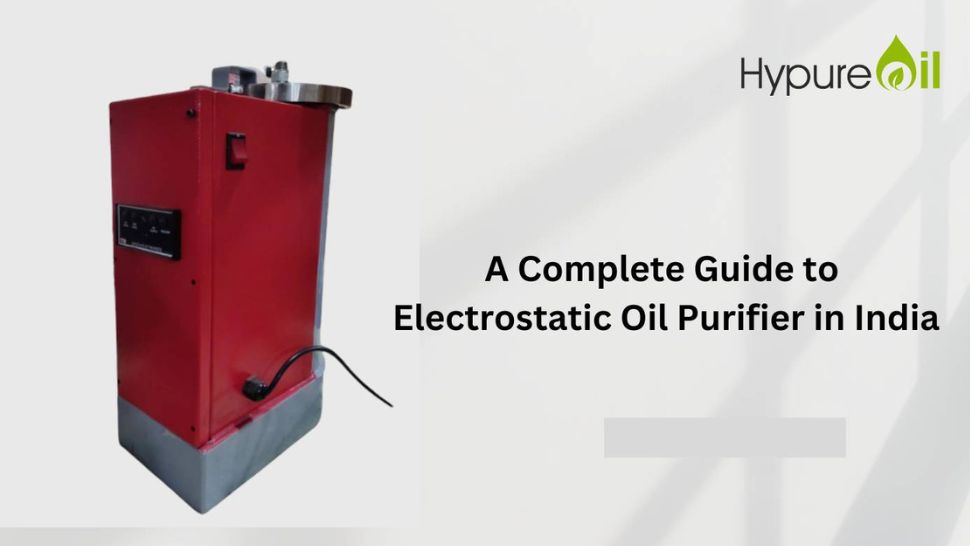An Electrostatic Oil Purifier in India is a device designed to remove impurities and contaminants from various types of oils, such as transformer oil or lubricating oil. It works on the principle of electrostatic precipitation, a process that utilizes electric fields to attract and capture particles.
Detailed Understanding about Electrostatic Oil Purifier
• Inlet and pre-filtration:
The contaminated oil is first drawn into the Electrostatic Oil Purifier through an inlet. Before entering the electrostatic chamber, it often passes through pre-filtration systems like mesh filters or cyclone separators. These preliminary filters remove large particles and debris from the oil, preventing them from entering the electrostatic chamber.
• Electrostatic precipitation:
The heart of the Electrostatic Oil filter is the electrostatic chamber, which typically consists of two main components: a series of charged electrodes and a collection chamber.
(a) Electrodes: Inside the electrostatic chamber, there are pairs of charged electrodes. These electrodes are typically made of metal and are charged with high-voltage direct current (DC) electricity. One electrode is positively charged, and the other is negatively charged.
(b) Dielectric barrier: In between the pairs of electrodes, there’s a dielectric barrier. This barrier helps maintain the separation between the positively and negatively charged electrodes.
• Ionization and particle charging:
As the oil flows through the electrostatic chamber, it passes very close to the charged electrodes. The high-voltage DC field created between the electrodes causes the molecules in the oil to ionize. This ionization process effectively charges the particles suspended in the oil. This includes both the negatively and positively charged particles.
(a) Positively charged particles: Positively charged particles, such as dust, soot, and other contaminants, are attracted to the negatively charged electrodes. These particles adhere to the surfaces of the negatively charged electrodes.
(b) Negatively charged electrodes: Conversely, negatively charged particles, which may include dissolved metals and other impurities, are attracted to the positively charged electrodes. They adhere to the positively charged electrodes.
• Particle collection:
The charged particles are collected on the surfaces of the electrodes, creating a layer of contaminants. Over time, this layer thickens as more particles are captured.
• Cleaning or regeneration:
Periodically, the Electrostatic Oil Purifier needs to undergo a cleaning or regeneration process. This is done to remove the accumulated contaminants from the electrodes. The process of regeneration differs from system to system because they use two different processes.
(a) Reverse polarity: Some systems reverse the polarity of the electrodes. This reverses the charges on the electrodes, causing the particles to detach and fall into a collection chamber or sump at the bottom of the purifier.
(b) Scrapping or rapping: In other systems, mechanical scrapers or rappers physically dislodge the accumulated contaminants from the electrodes. These particles then fall into a collection chamber for removal.
• Clean oil outlet:
After the contaminants are removed from the oil, it exits the Electrostatic Oil Purifier as cleaner, purified oil. This oil can be returned to its original application, such as in a transformer or a lubrication system.
One can summarize that an Electrostatic Oil filter uses electrostatic precipitation to remove impurities from oil by charging the particles and attracting them to oppositely charged electrodes. This technology is highly effective at removing both solid and dissolved contaminants from various types of oils, extending the life of the oil and the equipment it serves.
Delivering the best product, designed and manufactured with expertise and experience, is one of the Hypureoil aims to ensure that you can enhance the life of your units. So, if you are looking for the best Electrostatic Oil Purifier, you need to contact Hypureoil because we are the best when it comes to oil filtration systems. Over the years, we have provided high-quality products to a number of our customers, and we are able to prove our trustworthiness. One of the primary reasons why we’re chosen by so many people worldwide is the quality of the products that we sell; not only that, but also the varied variety of products in this respect. Therefore, if you’re looking for any other oil filtration products, visit our website asap.
FAQ’s
In simple terms, an electrostatic oil purifier is a device that uses electrostatic technology to remove contaminants from existing oil. This process extends the oil’s lifespan and helps improve equipment performance. It is widely used in industrial machinery, manufacturing, power generation, transportation, etc.
The primary benefit of an electrostatic oil purifier is that it removes dirt, wear particles, and oxidation products from the oil. This increases the lifespan of the machinery and improves its performance as well. An electrostatic oil filter also contributes to environmental preservation as it reduces the need for frequent oil changes and disposal.
The cleaning frequency of an electrostatic oil filter will depend on the specific model and how dirty the oil is. However, most electrostatic oil purifiers require periodic cleaning or regeneration to remove accumulated contaminants from the electrodes. You can consult with the company regarding cleaning the purifier.
Electrostatic liquid refers to the application of electrostatics to liquids for different purposes. The two applications you’ll encounter are electrostatic liquid coating, which uses electrical charges to attract paint particles to the object being coated and electrostatic liquid cleaning which uses an electrostatic field to remove contaminants from liquids, often used for purifying oil.
Yes, electrostatic oil purifiers are the most efficient machines against hydraulic and lubrication oils. They can remove a wider range of contaminants than traditional filters, including very fine particles, oxidation products, and even some water. This can help extend the life of the oil and improve the performance of the equipment.


